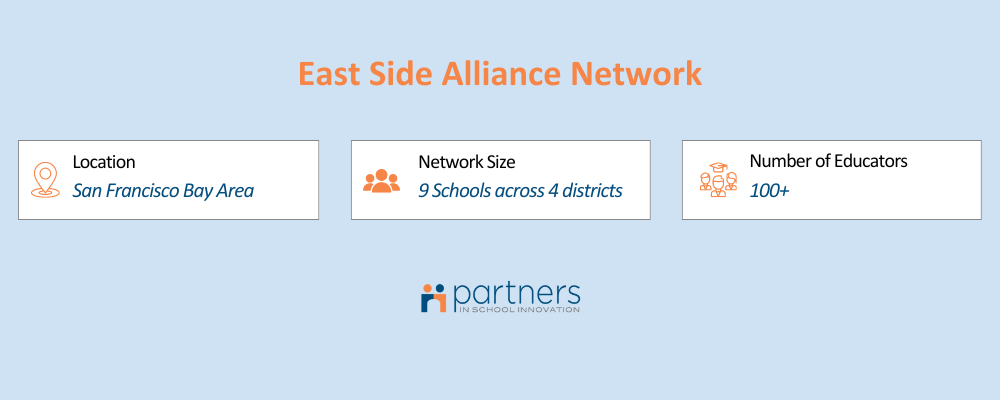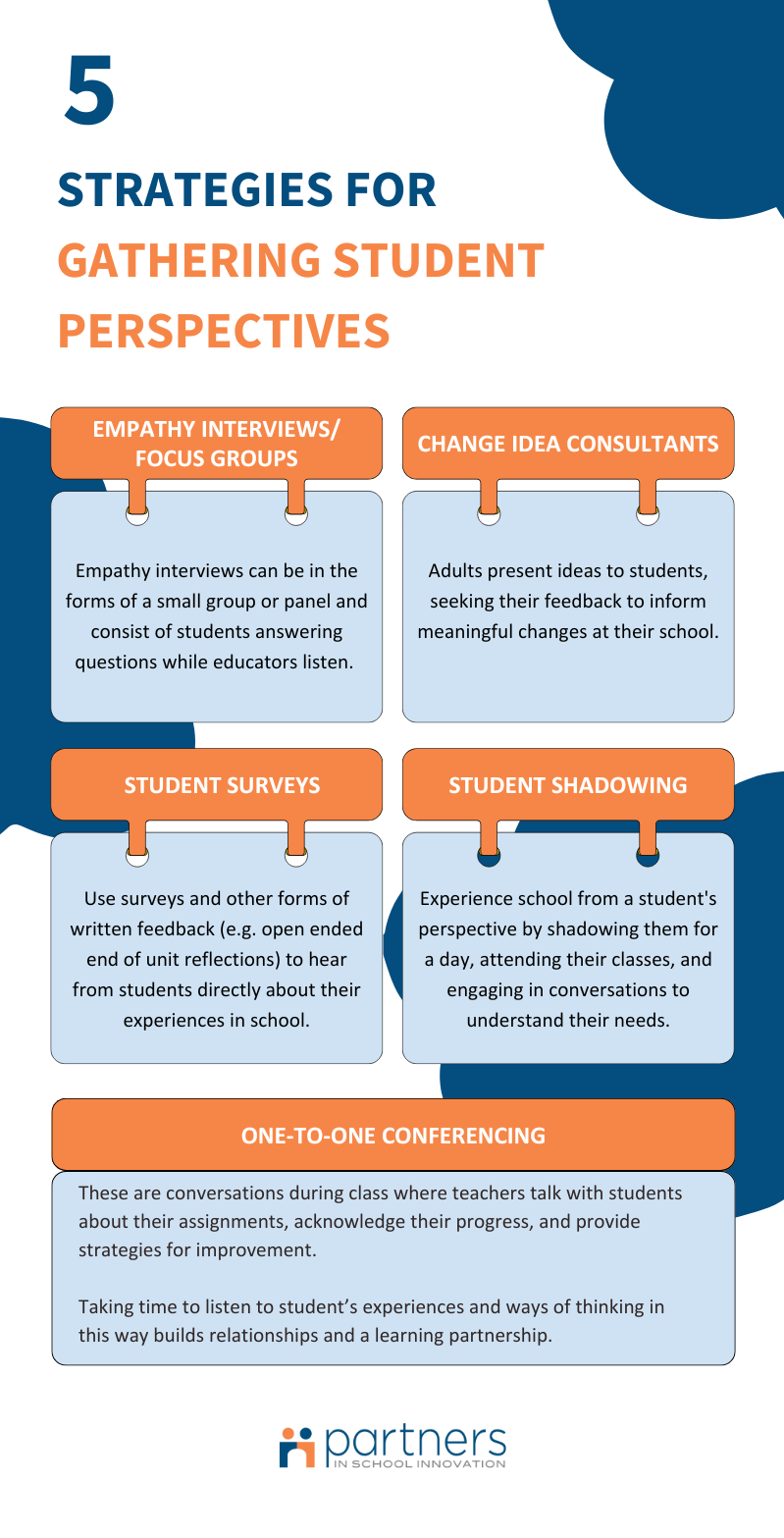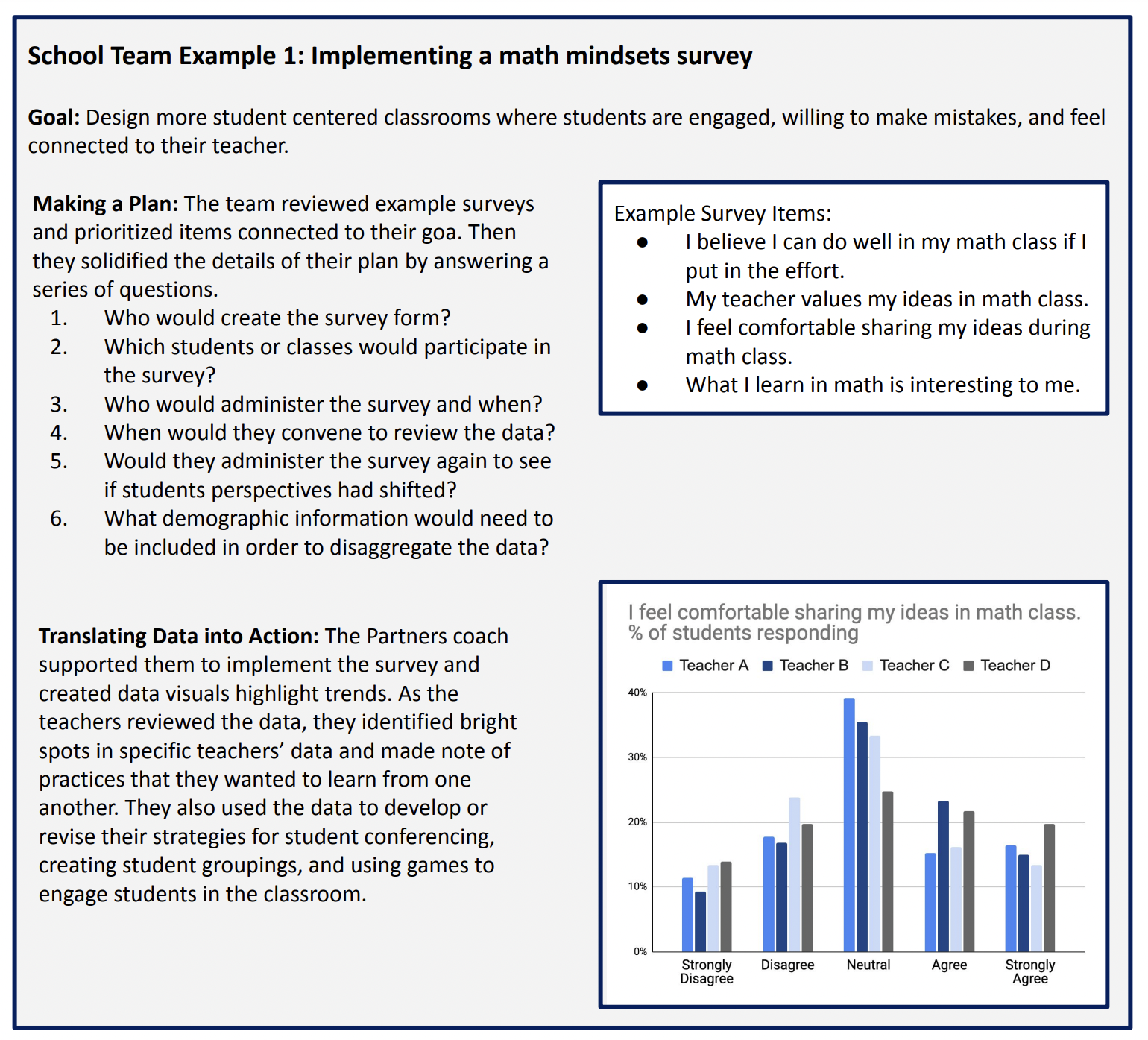How a Network of San Jose Schools Leveraged Student Voices for Transformative Change
At Partners in School Innovation, we believe that understanding students’ experiences through their own voices is foundational to creating educational environments that foster equity and empowerment.
This case study highlights part of our work with the East Side Alliance (ESA) network in San Jose, CA, which aimed to amplify the voices of Latine, English Language Learners, and low-income students across nine schools.
What is the East Side Alliance (ESA) Network?
The ESA Transformation Network, now in its third year, is a four-year initiative that brings together educators from nine schools across four districts. Facilitated by Partners in School Innovation (PSI), the network's goal is to provide educators with the tools and knowledge necessary to transform their schools and maintain student success long after the program ends.
An infographic that shows demographic details about the East Side Alliance Network located in the San Francisco Bay area. It includes the network size (9 schools across 4 districts) and number of educators (100+).
While the overarching work of the ESA network addresses many educational focus areas, this case study will focus on the efforts during the 2021-2022 school year to amplify student voices.
By prioritizing student feedback, educators worked to create a culture at their schools where teaching practices and administrative decisions are shaped by the needs and aspirations of the students, making education increasingly responsive and relevant.
Goals and Hypothesis for the Initiative to Amplify Student Voices
PSI coaches and the educators in this network predicted that amplifying student voices would help create welcoming school communities and help educators develop a strong vision for student success. It was also expected to improve teacher-student relationships in each of the participating schools.
Starting Improvements With Equity Mindsets
Before putting into action any new action plans or engaging with students, Partners in School Innovation set the foundation for meaningful change by first grounding educators in equity mindsets.
The goal of first grounding educators in equity mindsets was to ensure that all decisions and actions throughout this work were informed by, and beneficial to, the students.
Three mindsets they emphasized in particular were:
Belief in students and respect for community
This mindset encourages educators to seek solutions that center students. It also urges them to remember their role in modeling positive mindsets and language, acknowledging their influence on the entire school community.
Results orientation
This mindset focuses on maintaining a clear vision for what successful outcomes for students look like and using those outcomes as a north star to continually improve educational practices.
Systems thinking
This mindset promotes moving beyond assumptions to make decisions based on data, as well as focusing on what’s in their control.
These mindsets are a necessary foundation for educators to engage in deep listening, confront biases, and understand the power dynamics within the educational system.
To develop these mindsets during network meetings, educators explored their racial identity development and closely connected with their “why,” or personal motivations for teaching.
Graphic detailing foundational equity mindsets for educators, including belief in students, results orientation, and systems thinking.
Learning from Early Implementers
A few school sites started their work on amplifying student voices ahead of other schools in the network. During one network-wide professional development session, these early implementers shared insights and outcomes from their work with the other educators.
They offered practical examples of how they engaged student voices and shared lessons they learned that could be applied to future planning.
Early implementers specifically shared two strategies they used to gather and center student perspectives in their work as educators:
Empathy interviews
One school highlighted their approach of conducting empathy interviews. This involved teachers selecting a handful of students, particularly those not meeting academic goals, to gain a deeper understanding of their educational experiences, as well as the barriers and challenges they were facing.
Math mindset survey
Educators from a different school shared their use of a math mindset survey to understand students' sense of belonging and value in math classes. This helped teachers identify the emotional and mental barriers students were facing in math, leading to more supportive teaching strategies.
Along with learning from early implementers' experiences, professional development sessions facilitated by Partners in School Innovation shared more ways to capture and understand student perspectives. These sessions provided strategies, resources, and ongoing support to help schools implement these approaches effectively. Educators also received more individual coaching on implementation at their school sites from a Partners in School Innovation coach.
Infographic outlining five strategies for gathering student perspectives, including empathy interviews, change idea consultants, student surveys, student shadowing, and one-to-one conferencing.
Action Planning and Implementation at School Sites
Using insights and resources from the network sessions, educators were inspired to tailor these approaches to their unique student communities. Some school teams adopted strategies similar to those of early implementers, while others experimented with different methods discussed during professional development sessions. Over several months, school teams put their plans into action, focusing on amplifying student voices in their settings.
After analyzing student feedback, school teams determined the necessary actions and adjustments to respond to themes from the data.
Below is an example from one school that implemented a student survey to better understand and improve student engagement and experience in math instruction.
Detailed example of how a school team implemented a math mindsets survey, including their steps for planning, data translation into action, and a bar chart showing student responses.
Drawing on insights from students, educators across the network implemented various school and classroom adjustments such as:
Reorganizing classroom layouts to foster equitable engagement
Modifying policies for late work and missed assignments to accommodate student absences
Conducting one-on-one conferences with students to address their specific needs
Infusing games into classroom instruction to improve engagement
Adjusting classroom group work and student groupings for better collaboration
The Network’s Impact
As the 2021-2022 school year concluded, PSI and the educators on the ESA network team assessed the effectiveness of the student voice initiatives. They revisited the initial goals of enhancing conditions for student success, creating a welcoming school community, and establishing a strong vision for student achievement.
Many school teams saw significant improvements in these areas, and in some cases schools noticed that changes were limited to specific departments and not school-wide.
Overall the work on student voices has been highly valued by both teachers and leaders, inspiring a continued commitment to incorporate and spread student perspectives into their educational strategies.
Inspired by These Schools’ Journeys?
If you're interested in learning more about how Partners in School Innovation can support your district’s and school's path to transformation or want to explore how our staff can empower your team to achieve exceptional outcomes, contact us today.




